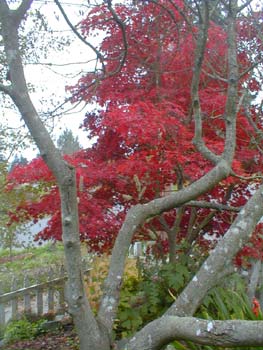
Purple-Leaf or Red
Japanese Maple
"The morns are meeker than they were,
The nuts are getting brown;
The berry's cheek is plumper,
The rose is out of town.
The maple wears a gayer scarf,
The field a scarlet gown."
-Emily Dickinson
1830-1886
"The scarlet of the maples can shake me like a cry
Of bugles going by."
-Bliss Carman
1861-1929
1830-1886
1861-1929
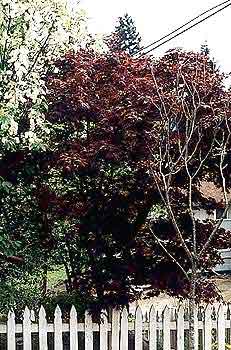 This large old Acer palmatum atropurpureum, the red or purple Japanese maples, is twenty-odd feet tall, with delicate-looking deeply cut maple leaves.
This large old Acer palmatum atropurpureum, the red or purple Japanese maples, is twenty-odd feet tall, with delicate-looking deeply cut maple leaves.The first photo is from November (2004) showing the maple in red autumn garb, through the trunks of the already leafless choke cherry, as viewed while standing in the front yard.
The second picture was snapped from its opposite side, from the street, in May (2002). For most of spring & all of summer, the tree is deep purple. The May photo captures part of the huge choke cherry in full bloom. The nearby late-leafing Staghorn Sumac hasn't yet gotten its spring leaves.
This maple has tiny flowers in late April or early May. The second photo was snapped in mid-April (2003), showing the little dangly flowers as richly red as the freshest new leaves.
Rapidly on the heals of these little red flowers, mothwing seeds arrive. The fourth photo is from May's end (2004) showing the seeds at their most colorful pink & yellow. These will cling to the branches throughout summer & not begin to fall until autumn.
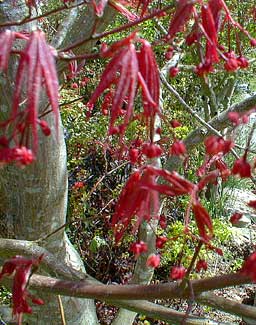 The mothwing seeds as well as the leaves turn bright red in Autumn, & these seeds continue to cling to the branches for a while even after autumn leaves start falling. Week by week right through winter these seeds will be blown from the limbs.
The mothwing seeds as well as the leaves turn bright red in Autumn, & these seeds continue to cling to the branches for a while even after autumn leaves start falling. Week by week right through winter these seeds will be blown from the limbs.In its Autumn colors it has no hint of the earlier purple remaining, the whole tree seeming to be a bright red flame. The fifth photo shows the autumn leaves in close-up in November (2003). Between the second & third week of November the leaves will fall to the ground forming a bright red mulch. We make sure the leaves are not covering any small plants, & knock them from small understory shrubs, but otherwise leave them in the garden to slowly turn to leafmold.
Several more fall portraits can be seen on the Atropurpureum page of the Autumn Trees Gallery.
So the colorfulness of this tree is quite changeable through the year. The leaves & blossoms emerge red in spring, leaves soon hardening to a rich mahogany-purple, holding this color through summer. Then by late September or early October the leaves fade momentarily to olive-green before they start through a series of red shadings until they achieve the most startlingly fiery red in November, then is still very beautiful in leafless winter.
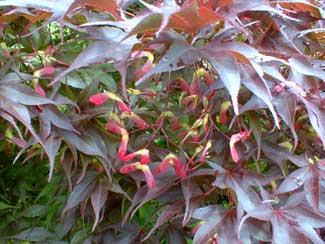 Atropurpureum is a naturally occurring variant having numerous cultivars. The surprising ease by which A. palmatum spontaneously mutates has caused the greatest focus on this species, from which growers continously developing new strains for size, form, leaf types, & color.
Atropurpureum is a naturally occurring variant having numerous cultivars. The surprising ease by which A. palmatum spontaneously mutates has caused the greatest focus on this species, from which growers continously developing new strains for size, form, leaf types, & color.The extraordinary variety seen in cultivation is the result of hybridizations with selected mutations, variants, & subspecies, & sometimes with other species of maples altogether, most especially with A. japanocum.
These maples have many features that make them ideal for our Northwest gardens, foremost being their extreme beauty & variety.
They are hardy & easily grown in our zone. They leaf out early in spring & drop their leaves late in autumn. During their brief leafless stint in winter, they have lovely limb forms & shapes, & smooth beautifully streaked snakeskin barks.
They do fine in various degrees of shade so that if other trees are planted closeby they suffer no adverse effects from the crowding, & do excellently in urban settings where large buildings deny gardeners much in the way of full sun options.
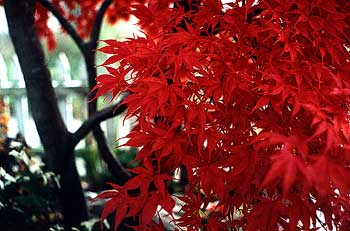 They are rarely attacked by insects nor injured by air pollution. Although the Chokecherry that crowds the Atropurpurea is elderly & weakening in its old age, hence attractive to aphids & caterpillars, such pests simply never migrate to the maple.
They are rarely attacked by insects nor injured by air pollution. Although the Chokecherry that crowds the Atropurpurea is elderly & weakening in its old age, hence attractive to aphids & caterpillars, such pests simply never migrate to the maple.Most of the subspecies & hybrids grow to a maximum of 25 feet & are rather slow-growing, so do not outgrow smallish yards & can be planted quite near a house without putting the house at risk.
There are many dwarf varieties as well, so even the smallest yard has room for a Japanese maple. Even the partial drawback that some of the cultivars are rare & fantastically expensive is circumvented with Atropurpureum, which is at once a very beautiful & a comparatively affordable tree.
There is a separate page for our smaller purple maple A. palmatum var amoenum 'Oshio Beni.' We also have a semi-dwarf variety, A. palmatum 'Shishigashira' the Lion's Head Maple.